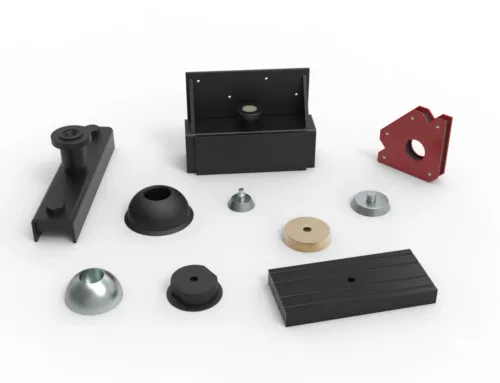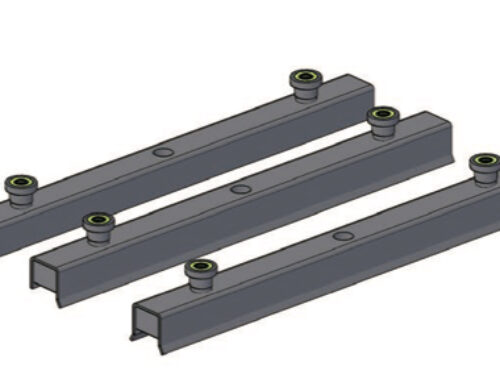If you’ve ever wondered how permanent magnets power so many of today’s cutting-edge devices, you’re in the right place. From electric vehicles to renewable energy systems, these magnets play a critical role in boosting efficiency and performance across industries. In this post, we’ll break down the most exciting applications of permanent magnets in modern technology, uncover the innovations driving their evolution, and show you why they’re indispensable in the tech landscape. Ready to see how permanent magnets are shaping the future? Let’s dive in!
Understanding Permanent Magnets
Permanent magnets are materials that produce a constant magnetic field without needing electricity. Unlike electromagnets, which require power to generate magnetism, permanent magnets keep their magnetic properties over time. They are essential in many modern technologies due to their reliability and energy efficiency.
Types of Permanent Magnets
Here are the main types used today:
| Type | Composition | Key Features | Common Uses |
|---|---|---|---|
| NdFeB | Neodymium, iron, boron | Very strong magnetic strength | EV motors, electronics, sensors |
| SmCo | Samarium, cobalt | High temperature resistance | Aerospace, military, motors |
| Alnico | Aluminum, nickel, cobalt | Good temperature stability | Sensors, microphones, pickups |
| Ferrite | Ceramic iron oxide | Cost-effective, corrosion-resistant | Speakers, magnetic separators |
Why Permanent Magnets Matter
- Long-lasting magnetism without continuous power
- Strong magnetic force in compact sizes
- Wide temperature range for different uses
- Cost-effective in many applications
Permanent Magnets vs Electromagnets
| Feature | Permanent Magnets | Electromagnets |
|---|---|---|
| Power | No external power needed | Requires continuous electric current |
| Size and weight | Usually smaller and lighter | Bulkier because of coils and power supply |
| Control | Fixed magnetic field | Magnetic strength controlled by current |
| Cost | Lower operating cost | Higher due to electricity consumption |
Permanent magnets offer simplicity and efficiency, which is why they play a key role in the technology we use every day.
Core Applications of Permanent Magnets in Electronics and Consumer Devices
Permanent magnets play a vital role in everyday electronics and consumer gadgets. You’ll find neodymium magnets widely used in headphones, microphones, and speakers because they deliver strong magnetic fields in small, lightweight packages—perfect for clear, powerful sound. Smartphones also rely on these magnets for functions like vibration alerts and small speakers.
Beyond sound, permanent magnets are key in sensors that detect motion, position, or proximity, helping devices respond accurately in real time. They’re also crucial in magnetic storage devices like hard disk drives (HDDs), where magnets control the read/write heads, enabling fast and reliable data storage.
In modern tech, the use of permanent magnets keeps devices efficient, compact, and responsive, meeting the high expectations of U.S. consumers for performance and reliability. For more insights on neodymium magnets and their applications, you can explore NBAEM’s magnetic assemblies to see how these materials fit into different device designs.
Core Applications of Permanent Magnets in Modern Technology Renewable Energy Solutions
Permanent magnets play a crucial role in today’s renewable energy sector. In wind turbine generators, especially those using permanent magnet synchronous motors (PMSM), magnets help convert wind energy into electricity more efficiently. These magnets provide strong magnetic fields without extra power consumption, making turbines more reliable and energy-efficient.
Solar energy systems also benefit from permanent magnets. Solar trackers, which adjust the panels’ position to follow the sun, rely on these magnets in their motors for smooth and precise movement. This improves energy capture throughout the day. Additionally, energy-efficient systems across the renewable sector often use magnets to boost performance and reduce energy loss.
Thanks to neodymium magnets and other rare earth magnets widely used in these applications, renewable energy tech is more powerful and compact—perfect for meeting the growing demand for clean energy in the U.S.
Core Applications of Permanent Magnets in Modern Technology Automotive Industry
Permanent magnets play a vital role in the automotive world, especially with the rise of electric vehicles (EVs) and hybrids. In EV motors and hybrid vehicle traction motors, neodymium magnets are essential for creating powerful, efficient, and compact motors that help improve range and performance. These magnets deliver strong magnetic fields while keeping the motor size and weight down, which is a big plus for U.S. drivers wanting longer battery life and better handling.
Beyond the motor, permanent magnets are crucial in sensors and actuators used in advanced driver assistance systems (ADAS). These systems rely on magnetic sensors for functions like collision avoidance, adaptive cruise control, and lane departure warnings. The accuracy and reliability of rare earth magnets ensure these safety features work smoothly, giving drivers added confidence on the road.
In sum, whether it’s powering the drivetrain or enabling smarter safety technologies, permanent magnets are driving the future of automotive innovation right here in the U.S.
Core Applications of Permanent Magnets in Industrial and Manufacturing
Permanent magnets play a crucial role in industrial and manufacturing settings, powering many key processes that keep production efficient and reliable. In robotics and automation, permanent magnet motors and generators are preferred for their high efficiency and durability. These magnets help deliver strong, consistent performance, enabling precise movements and reducing energy consumption.
Magnetic separators are another important use, especially in industries handling raw materials or recycling. Permanent magnets quickly remove metal contaminants from products, ensuring quality and protecting machinery from damage.
Lifting equipment also relies on these magnets to move heavy metal parts safely and effectively without the need for mechanical grips. This improves safety and speeds up material handling in factories and warehouses.
In , permanent magnets are essential in industrial tech for:
- Efficient motors and generators in robotics and automation
- Reliable magnetic separators for contaminant removal
- Safe, strong lifting magnets to handle heavy materials
These applications showcase how integral permanent magnets are in boosting productivity and safety in manufacturing.
Core Applications of Permanent Magnets in Medical Technology
Permanent magnets play a crucial role in medical technology, especially in devices like Magnetic Resonance Imaging (MRI) machines. These magnets provide the strong, stable magnetic fields needed to create detailed images of the inside of the body, helping doctors diagnose conditions more effectively. Beyond MRI, permanent magnets are found in other medical equipment such as portable diagnostic tools, hearing aids, and precision surgical instruments.
Advances in permanent magnet materials have led to smaller, more efficient, and more powerful magnets, enabling the development of new therapeutic devices like magnetic stimulation systems for pain relief and rehabilitation. This progress also supports more accurate, non-invasive diagnostics, making medical care safer and more comfortable for patients. Using high-performance magnets in these devices ensures reliability and improved outcomes in healthcare settings.
Emerging Trends and Innovations in Permanent Magnet Technology
The world of permanent magnets is constantly evolving, especially with the push for better performance and sustainability. One major trend is the development of high-performance neodymium magnets that deliver stronger magnetic fields while using less material. Alongside these, researchers are exploring rare-earth alternatives to reduce dependence on limited resources, making magnet supply more secure for U.S. industries.
Miniaturization is another key focus. Smaller, more efficient magnets are powering compact devices and enabling advances in magnetic sensor technology and smart IoT applications. These tiny magnets help improve performance without taking up extra space, which is crucial in consumer electronics and automotive sectors.
Environmental sustainability is also gaining traction. Manufacturers are working on greener processes to produce permanent magnets with lower energy use and less waste. This includes developing recycling methods and adopting cleaner raw materials to meet the rising demand for eco-friendly magnetic materials in technology.
Overall, innovations in magnet efficiency, size, and sustainability are shaping how permanent magnets boost modern technology across America—from smart devices to renewable energy and beyond.
Choosing the Right Permanent Magnets for Your Application
Picking the right permanent magnet means balancing a few key factors based on what your project needs. Here’s what to keep in mind:
-
Performance Requirements
Consider how strong the magnetic field needs to be. Neodymium magnets are top performers for high magnetic strength, while ferrite magnets suit less demanding uses. Also, think about how stable the magnet needs to be under different temperatures—some magnets like SmCo handle heat better, which is important for industrial or automotive applications.
-
Temperature and Corrosion Resistance
If your application faces high heat or harsh environments, choose magnets that won’t lose strength or degrade. Alnico and SmCo magnets offer great temperature resistance. For moisture or corrosive settings, coatings or corrosion-resistant materials matter a lot.
-
Cost-Effectiveness and Availability
Rare earth magnets like neodymium are powerful but tend to cost more and sometimes face supply chain issues. Ferrite magnets are more budget-friendly and widely available. It’s important to find a magnet that fits your budget without compromising too much on performance.
At NBAEM, we offer a broad portfolio of permanent magnets, including neodymium, samarium-cobalt, alnico, and ferrite magnets. Plus, we provide customization options tailored to your specific needs—whether it’s size, shape, magnetic strength, or coating. This flexibility helps you get exactly what your technology requires, with reliable sourcing to keep your projects on track.
Challenges and Future Outlook for Permanent Magnet Applications
The supply chain for rare earth elements, essential for high-performance neodymium magnets, faces ongoing geopolitical challenges. Much of the world’s supply comes from limited regions, which can cause price spikes and availability concerns. This impacts industries relying on permanent magnet motors, especially in the U.S. where demand for electric vehicles and renewable energy solutions is rising fast.
Recycling efforts are growing to address sustainability and reduce dependence on new mining. Recovering rare earth materials from old electronics and magnets not only cuts costs but also supports environmental goals. Innovations in magnet recycling technologies are making these processes more efficient and practical for large-scale use.
On the technology front, breakthroughs are underway to improve magnetic materials. Researchers focus on boosting magnetic strength, temperature resistance, and reducing reliance on scarce rare earths. Emerging alternatives and improved alloys could reshape permanent magnet motors and magnetic sensors, opening new possibilities in industrial and automotive fields.
Staying ahead means balancing current material limits with smarter, greener solutions—key for businesses looking to keep permanent magnets reliable and affordable over the long haul.





[…] Regionally, the China APAC market drives much of the growth. Local companies push for cost-effective, high-quality magnets that meet rapid industrial demands. This focus accelerates innovation and affects global trends in permanent magnet uses. For more on the types of magnets and their modern roles, check out permanent magnet applications in modern technology. […]
[…] a deeper look at the materials NBAEM offers, check out the permanent magnet applications in modern technology and learn why their neodymium magnets are a smart choice for wind generators at NdFeB magnet used […]